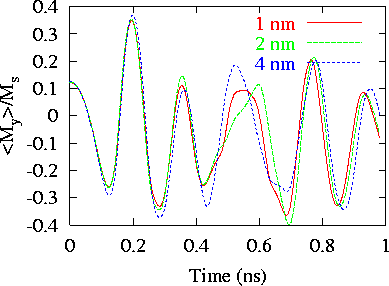µMAG Standard Problem #4 results
See the problem specification.
Disclaimer
µMAG could not succeed without the contributions
of colleagues working outside NIST. Although we value the
contributions made by these colleagues, NIST does not necessarily
endorse the views expressed or the data presented in the submitted
solutions shown below.
Solution directory
- Comparisons
- G. Albuquerque,
J. Miltat and A. Thiaville
-
R. D. McMichael, M. J. Donahue, D. G. Porter, and
J. Eicke
-
Liliana Buda, Lucian Prejbeanu, Ursula Ebels and Kamel
Ounadjela
-
E. Martinez, L. Torres and L. Lopez-Diaz
-
José L. Martins and Tania Rocha
-
P.E. Roy and P. Svedlindh
-
Massimiliano d’Aquino, Claudio Serpico,
and Giovanni Miano
-
Dmitri Berkov
-
M. J. Donahue and D. G. Porter
-
Rasmus Bjørk, E. B. Poulsen and A. R. Insinga
Submitted Solution: José L. Martins and Tania Rocha
- Date:
- December 16, 2001.
- From:
- José L. Martins and Tania Rocha
INESC, Lisbon, Portugal
- Contact:
-
José Martins
These calculations were done using a finite-difference scheme, always
with two cells across the thickness of the sample. Three mesh sizes
were used: approx. 1 nm cells, approx. 2 nm cells and approx. 4 nm
cells (in the two larger axis of the sample).
The LLG equations were solved using 2nd order or 4th order Runge-Kutta.
time step of 1e-14 s and adaptive time step (if torque surpasses a
specific value, time step is decreased to half its value, if torque is
considered very low, time step is doubled to speed up
calculations).
The demagnetization field is calculated solving the Poisson equation
numerically using a Multigrid method. The boundary conditions are
obtained calculating multipole expansion of magnetic charge inside
bigger cells and then integrating this expansion.
Exchange interactions were calculated for the 6 neighbours (well, in
this case, 5 neighbours) of each cell.
Results:
- Field 1

Results obtained for Field 1 with 1 nm cells and 2 nm cells are
very similar, almost equal. Results obtained with 4 nm cells have some
differences.
- Field 2

Results for Field 2 are different for different mesh sizes, and
these differences increase as time passes.
Data:
Average magnetization vs t
Magnetization data when first crosses zero
Please send comments to [email protected] and join the
µMAG discussion e-mail list.
Site Directory
µMAG organization / NIST CTCMS /
[email protected]
11-NOV-2021

